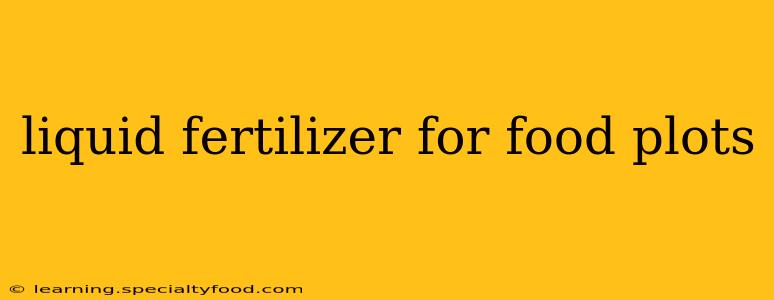Choosing the right fertilizer is crucial for establishing thriving food plots that attract and sustain wildlife. Liquid fertilizers offer several advantages over granular options, particularly for food plots where quick results and efficient nutrient delivery are paramount. This guide delves into the benefits, types, application methods, and considerations for using liquid fertilizer in your food plots.
What are the benefits of using liquid fertilizer for food plots?
Liquid fertilizers offer several key advantages over their granular counterparts, making them a popular choice among hunters and landowners seeking to maximize food plot success. These benefits include:
- Faster nutrient uptake: Liquid fertilizers dissolve quickly in the soil, allowing plants to absorb nutrients almost immediately. This rapid nutrient availability is particularly beneficial for establishing seedlings and promoting vigorous early growth.
- Improved nutrient efficiency: The application method ensures direct contact with the plant roots and soil, minimizing nutrient loss due to runoff or leaching. This leads to better nutrient utilization and cost savings.
- Targeted application: Liquid fertilizers can be applied directly to the plant foliage (foliar feeding) or to the soil, offering flexibility depending on your specific needs and the stage of plant growth.
- Easy application: Liquid fertilizers can be applied using various equipment, from simple hand-held sprayers to larger ATV-mounted sprayers, depending on the size of your food plot. This makes application relatively straightforward.
- Suitable for various soil types: Liquid fertilizers can be tailored to different soil types, making them adaptable for diverse plot locations and conditions.
What are the different types of liquid fertilizers for food plots?
Several types of liquid fertilizers cater to the specific needs of food plot establishment and maintenance. Common types include:
- Nitrogen (N): Essential for vegetative growth, nitrogen is often the most crucial nutrient for food plots. Liquid nitrogen sources include urea-ammonium nitrate (UAN) solutions.
- Phosphorus (P): Critical for root development and flowering, phosphorus ensures strong, healthy plants. Liquid phosphorus fertilizers are available in various formulations.
- Potassium (K): Important for disease resistance and overall plant health, potassium aids in stress tolerance. Liquid potassium fertilizers provide this crucial element in a readily available form.
- Complete liquid fertilizers: These blend nitrogen, phosphorus, and potassium along with micronutrients. They offer a balanced approach to food plot fertilization, providing all the essential nutrients in a single application. The NPK ratio (e.g., 10-10-10, 15-15-15) indicates the proportion of each nutrient.
Remember to choose a fertilizer blend that aligns with the specific nutrient requirements of your chosen food plot species and your soil's existing nutrient levels. A soil test can help determine the optimal fertilizer blend.
How do you apply liquid fertilizer to food plots?
The application method depends on the type of liquid fertilizer and the size of your food plot. Common methods include:
- Hand-held sprayers: Ideal for smaller plots, hand-held sprayers offer precise control and are easy to maneuver.
- ATV or UTV mounted sprayers: These are more efficient for larger food plots, allowing for quicker coverage.
- Calibration: Regardless of the equipment used, proper calibration is crucial to ensure the correct application rate. This prevents over-fertilization, which can damage plants, and under-fertilization, which limits growth.
What are the best liquid fertilizers for different food plot plants?
The ideal liquid fertilizer will vary depending on the plant species. Research the specific nutrient requirements of your chosen plants (e.g., clover, brassicas, corn) to select the appropriate fertilizer blend and application timing.
What is the best time of year to apply liquid fertilizer to food plots?
Optimal timing depends on the plant species and your location's climate. Generally, applying liquid fertilizer in the spring during active plant growth is beneficial, providing a boost when plants need nutrients for robust development. A second application may be needed later in the season, depending on plant needs and soil conditions.
How much liquid fertilizer should I apply to my food plot?
The application rate depends on several factors, including the type of fertilizer, the nutrient content of the soil, and the type of plant. Following the instructions on the fertilizer label carefully is crucial to avoid over-fertilization or harming the plants.
Can I mix different liquid fertilizers together?
Mixing different liquid fertilizers may be possible, but always check the compatibility of the products before doing so. Some fertilizers may react negatively when mixed, reducing their effectiveness or even creating harmful compounds. Refer to the manufacturer's instructions for mixing guidelines.
By carefully selecting and applying liquid fertilizer, you can significantly enhance your food plot's productivity and attractiveness to wildlife. Remember to conduct a soil test to understand your soil's nutrient levels and choose a fertilizer blend tailored to your needs. Consistent monitoring and adjustment, based on plant growth and visual assessments, are key to maximizing the benefits of liquid fertilization in your food plot management strategy.
